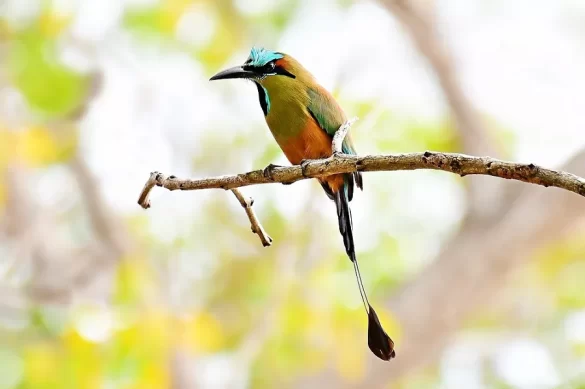The national bird of El Salvador is the Turquoise-browed Motmot, also known as Guardabarranco in Spanish. This beautiful bird is an iconic species found throughout Central America and is celebrated for its unique appearance and cultural significance.
Appearance and Physical Characteristics
The Turquoise-browed Motmot has a distinctive appearance that sets it apart from other bird species. It has a colorful plumage that consists of green, blue, and turquoise feathers. Its tail feathers are long and have distinct markings that resemble tennis rackets. These feathers have a unique adaptation that allows them to vibrate rapidly, creating a buzzing sound that attracts potential mates or warns off predators.
This bird’s most notable physical feature is the turquoise-colored patch on its forehead, which gives it its common name. The ornamental feathers extend down the neck, and the bird uses them to display during courtship or when threatened. The bird’s beak is long and curved, perfect for capturing insects, lizards, and small mammals.
Habitat and Distribution of The Turquoise-Browed Motmot
The Turquoise-browed Motmot is a colorful bird species found in various regions of Central America, including Mexico, Belize, Guatemala, Honduras, Nicaragua, Costa Rica and Panama. Its preferred habitat is tropical and subtropical forests, forest edges, and other wooded areas with thick vegetation cover.
Within its range, the Turquoise-browed Motmot can be found in a variety of habitat types, from dry deciduous forests to wet rainforests. They are also often found near rivers or streams, where they can hunt for small fish and other aquatic prey.
Overall, the distribution of the Turquoise-browed Motmot is relatively broad and continuous throughout much of Central America, although specific populations may be threatened by habitat loss and other environmental factors.
What Does the Turquois-Browed Motmot Symbolize?
The Turquoise-browed Motmot holds a significant place in Central American culture and has been celebrated in literature, music, and art. In El Salvador, the bird is considered a symbol of freedom and independence due to its association with the country’s fight for liberation from Spain in the early 19th century.
The bird’s name, Guardabarranco, translates to “ravine keeper” in English, referring to its habitat in forested areas near ravines. In some indigenous cultures, the bird is considered a guardian spirit and is believed to possess healing powers.
Conservation Status
Despite its cultural significance and beauty, the Turquoise-browed Motmot faces threats to its survival. Deforestation and habitat loss due to human activities, such as agriculture and urbanization, have contributed to declining populations of this species.
Additionally, the illegal pet trade poses a threat to the bird, as its unique appearance makes it a desirable species for collectors. The International Union for Conservation of Nature (IUCN) lists the Turquoise-browed Motmot as a species of “Least Concern” due to its widespread distribution and relatively stable populations. However, continued efforts are needed to protect this iconic bird and its habitat.
Efforts to Protect the Turquoise-browed Motmot
Several organizations in El Salvador and throughout Central America are working to protect the Turquoise-browed Motmot and its habitat. One such organization is the SalvaNATURA Foundation, which works to conserve biodiversity in El Salvador through education, research, and community outreach programs.
The foundation has established several protected areas in the country, including the Los Volcanes National Park, where the Turquoise-browed Motmot is found. These protected areas provide critical habitat for the bird and other endangered species, ensuring their long-term survival.
Some Fun Facts About the Turquoise-browed Motmot
The turquoise-browed motmot is a beautiful bird with a distinctive appearance and some interesting characteristics. Here are a few fun facts about this unique bird:
1. The turquoise-browed motmot is known for its long tail feathers, which it can use to maneuver through the forest canopy.
2. Motmots are members of the kingfisher family, but unlike most other kingfishers, they do not feed on fish. Instead, they primarily eat insects, lizards, and fruit.
3. The turquoise-browed motmot has a distinctive call that sounds like a low-pitched “wok” or “whoop.”
4. This species is found in Central America, from Mexico down to Costa Rica.
5. The turquoise-browed motmot is considered sacred by some indigenous cultures in Central America, and is sometimes associated with power, strength, and wisdom.
6. Like many birds, the turquoise-browed motmot plays an important role in seed dispersal, helping to spread the seeds of the fruits it eats throughout the forest.
7. These birds are monogamous and mate for life, typically building their nests in burrows dug into banks or cliffs.
Conclusion
The Turquoise-browed Motmot is a beautiful and culturally significant bird found throughout Central America. It is an important symbol of freedom and independence in El Salvador and holds spiritual significance in some indigenous cultures. Despite facing threats to its survival, efforts are underway to protect this iconic species and its habitat, ensuring that future generations can enjoy its beauty and cultural significance.


 Facebook
Facebook  Instagram
Instagram  Youtube
Youtube 